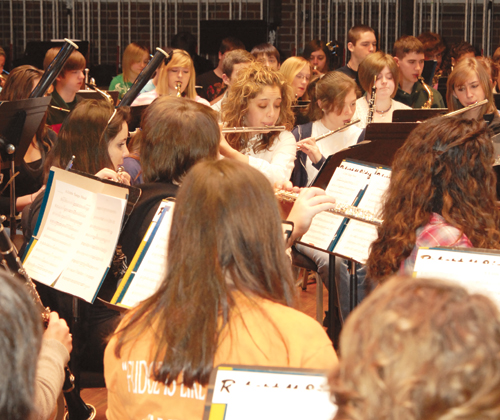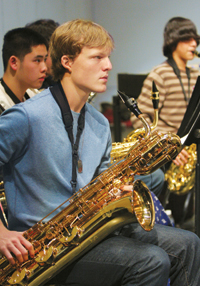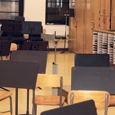
Habits are behaviors that are repeated regularly and often occur subconsciously. Both directors and students tend to cut corners at rehearsals. If these short cuts are not addressed, they may turn into bad habits. While teachers often focus on the bad habits of students, they may inadvertently encourage these behaviors as well as engaging in poor practices themselves. Spend a rehearsal noticing which of these traps you may have overlooked. Another good idea is to video record yourself and your students in rehearsal to discover problems that pass unnoticed.
Common Director Habits
Rehearsal order is not listed on the board before class.
This wastes time. Write the rehearsal order on the board and require students to find the music before rehearsal begins. It is much better to learn before a rehearsal starts that a student has lost the music to the Sousa march. I send out an e-mail to my university band the day before rehearsals with the order and objectives for each piece of music.
There is not enough room between the chairs.
Part of my job as a graduate assistant was to set up chairs and stands for the wind ensemble. Even when I became quite accomplished at this, my mentor would arrive early for rehearsal and touch the back of every chair to assess the position. He felt that the placement of the chairs was crucial. Players need room to sit comfortably, breathe, and move. It is unfortunate that some bands are forced to rehearse in ridiculously cramped quarters. I once attended a rehearsal where lack of space forced a tuba player into the doorway of an instrument storage room. Directors should consider the space requirements of players and avoid the temptation of squeezing one more flute player into the first row.
Singing along with the band
There is nothing wrong with singing in band class to provide an example for the students. Directors often encourage their players to sing through their instruments, and we all know if you can’t sing it, you can’t play it. The trouble starts when directors continually sing while the band plays. This prevents the director from listening to the ensemble. Directors sometimes develop this bad habit because they prefer their singing to the music the band is producing.
In the 1980s I directed a large middle school band and often found myself singing along with the group. The following year, I transferred to the area high school and knew this behavior had to stop. I went to the bank and obtained $20 in quarters and placed them in a bowl on the conductor’s stand. I then told members of the flute section to raise their hands every time they caught me singing. The person whose hand went up first would get a quarter. It cost less than 20 dollars to break this habit – it was money well spent.
Do not stop and restart the rehearsal without making corrections.
This happens more often than you think. When the director stops the group in rehearsal, say something – if not profound at least productive. The problem occurs when a director has trouble processing exactly what is wrong or knows there are problems, but cannot decide what to say. Starting and stopping without addressing performance problems is weak teaching.
What is said should be specific. When a director says, “start back at letter C and play it with more passion.” Students may not understand what that means and how to improve their playing.
Never rehearse without studying the score.
Often poor comments arise from lack of score study. Know the basics of the work, including melodic interests, significant harmonic events, form, and the predictable performance problems. Think in advance about how the work should sound and how you will give instruction. If you know the score well, you can listen more carefully for errors. Those who learn the score along with the band subject the ensemble to conducting errors and wandering opinions about the way a passage should be played. It is a poor example for students and shows that you have not bothered to prepare the music.
Avoid shouting instructions while the students are playing.
There are some situations where this is acceptable. I have attended rehearsals of major symphony orchestras where the conductor has given verbal instructions while the group is playing. This is usually done to adjust accompaniment volumes to enhance the work of a soloist. However, it is a good idea to avoid shouting instructions to the entire ensemble. By the time they figure out what you are saying, they are four measures further along.
Do not talk too much.
Avoid excessive talking during rehearsals and eliminate your daily speeches. Many times the speeches are not directly related to the task at hand and burn up rehearsal time. When I was an undergraduate, I had the chance to say a few words in a rehearsal with the university band. I managed to force out a few nervous phrases before I heard my director say, “stop talking so much, they only listen to the first three words anyway”.
Here are a few things to remember when you are speaking to a band in rehearsal:
• Study the music and prepare for rehearsal so you can anticipate problems and make clear verbal corrections
• Whether it is the first flutes or the entire ensemble, make sure you have their attention before speaking. Make eye contact before talking.
• Speak up – you will often be communicating to 40 or more musicians who are spread across the room
• Avoid lengthy instructions because students quickly forget what has been said. Just provide a few simple words or phrases and keep the band playing.
• Always stay calm and do not rush instructions. Some directors tend to become more animated, and their speech patterns become faster as the rehearsal progresses.
Avoid ineffective tuning
This is a common occurrence that uses a lot of rehearsal time and has no long-term benefit. The director will walk around the room every day with an electronic tuner and determine if the player is flat or sharp on a single pitch. Next he tells the student (the student does not decide) to push in or pull out according to how many cents they are off. Directors who tune in this manner are often the same ones who engage in the futile behavior of pointing to their ear during rehearsal and shouting listen, listen. These directors rely too much the tuner and avoid strategies that place the responsibility for tuning on the students. Instead teach the students the skills so they can listen for ensemble intonation:
• Students should understand the pitch tendencies and other inherent deficiencies of their instrument.
• Introduce the particulars of the overtone series as it relates to pitch.
• Discuss mechanical and physical ways to alter pitch.
• Sing pitches and have the students match the sung pitch on their instruments.
• Work with chorales.
• Sing a simple chorale and then as a comparison, have the band play the same chorale on their instruments and work for equal pitch presentation. Avoid chorales with extended ranges and complex scoring.
• Take the simple chorale and have students transpose it into all keys. This is a great project that develops intonation and addresses the pitch problems encountered in various keys.
Do not begin rehearsals with many announcements.
Greet early arrivals at the door with a smile on your face and get the rehearsal started as soon as possible. Nothing destroys enthusiasm for making music more than having to sit through information about the fruit sale deadline. Take care of most communications through e-mail or have announcements sometime between pieces. A good time might be before rehearsing the last piece of the day. There is nothing wrong with starting warmups before the bell rings. Students will learn to hurry to their seats, and rehearsal will be up and running before the bell rings.
Do not talk with your hands in the preparatory position.
This bad habit is often mentioned – probably because almost everyone does it. This sends a mixed message to the ensemble. Your hands signal that you are ready to start, and students will not know if they should focus on listening or prepare to receive the preparatory gesture. This action conditions the group to ignore conducting gestures.
The warmup rut
Adapt the warmup routine based on an assessment of what the ensemble should improve. This is a great opportunity to address techniques and broader concepts that the ensemble will encounter in current repertoire. At too many schools it is obvious that students play the same materials every day for a warmups. I have seen the director call for a page and number from the technique book, and the students leave the book in the folder and play from memory. I have also heard director say, “play the scale in whole notes,” and the students know which scale to play because they do the same one each day.
The warmup period is the best time to address ensemble tone and intonation. Wait until the students are sitting properly, holding their instruments correctly, and pushing warm and intense air through their instruments before moving to singing and pitch matching exercises.
Many of these bad habits are interrelated. If you correct one problem, the next one is often closer to a solution. Unfortunately, the opposite is also true. When the students and directors let things slip, the wheels can be off the road before you have a chance to make a correction. It is better to inspire and promote discipline than to administer punishment, so stay on top of potential bad habits. Every rehearsal is a performance for the director. The preparation and enthusiasm that you display every day will inspire students to work harder and leave no room for bad habits.
Bad Student Habits – Behavior
 Arriving late for rehearsals.
Arriving late for rehearsals.
This habit suggests a lack of focus and purpose within the organization. The band handbook should clearly define what it means to be late and list the consequences. Directors who consistently allow students to arrive late for rehearsals jeopardize ensemble morale.
Always begin rehearsals on time and start with everyone playing. Directors should prepare in advance what they will teach. Detailed planning allows the director to teach with confidence rather than reacting to events as they unfold. Lessons should feature intense learning followed by lighter moments; this creates a meaningful and fun rehearsal atmosphere. This tends to make attendance and punctuality less of a problem.
Food and drink in the band room.
Keep food away from the instruments and do not allow food in the rehearsal area before or during rehearsals.
Cases, books, backpacks
While a piccolo or flute case under a chair is not a big problem, inconsistent or unenforced rules lead to rehearsals where there is so much gear on the floor that students cannot sit properly or adjust the position of their chairs. Excessive clutter also adversely affects the rehearsal atmosphere and students’ ability to focus. Some of the things I have seen cluttering a band seating area are:
• Coats
• Majorette boots
• Cases for every instrument (often used as foot stool)
• Tennis racket
• Cat (actually a small kitten)
• Project posters
• Basketballs
• Food and drink
• Text books and backpacks (this is very common.)
• Multiple copies of Fahrenheit 451 and Lord of the Flies (on the stand and read during rehearsal).
• A boyfriend! Asleep on the floor in the 3rd clarinet section.
Address this problem in the band handbook and then enforce it consistently throughout the year. Direct students to keep personal items and cases outside the seating area.
Students pack up while final announcements are given.
Trumpet players intuitively know when a rehearsal is ending and will try to get a jump on leaving. The students who pack up early will be the same ones who come back later and say, “you never told us that.” I know one director who quickly broke this bad habit by asking students to take their instruments back out and play the last eight bars one more time.
Student Habits – Posture
Student chairs not facing the director or students not facing forward in chairs.
This is a problem because students will not be able to follow conducting gestures. Often the chairs of flute and tuba players angle away from the conductor’s podium so these students sit at awkward angles. Flute players occasionally sit with the right elbow thrown over the back of their chair. I once observed a middle school flutist at a band clinic who sat on the outside of the first row with her back facing directly toward the audience. The chair was correctly facing the conductor, but she had rotated her body 90° toward the interior of the ensemble. Take the time to be sure chairs face the conductor, instruments are held correctly, and everyone is sitting forward in their seats.
Stands are not the correct height.
Players should adjust the music stand so they can slightly angle their eyes upward to see over the stand and easily locate the conductor. Problems occur when the stand is positioned too low, and the student must pivot their head up to see the conductor. Students will avoid this annoyance and never look up. The warmup period is a good time to check stand heights and make corrections.
Poor posture
This bad habit causes significant performance problems. Do not allow the students to play with crossed legs, leaning on their elbows, or slouched back. They should sit up so their ribcage has room to expand. It is interesting to watch the posture of band students as I lead them through breathing exercises. I sometimes avoid mentioning posture and watch them begin to sit correctly as they take deep breaths and apply breath support.
Poor instrument position
Instruments can feel increasingly heavy for younger students and this leads to poor instrument position. Clarinet neck straps are inexpensive and help promote correct instrument and hand position while diminishing right thumb fatigue. Be sure saxophonists use their neck strap correctly and are not allowed to place their instrument at an extreme angle across their lap.
Young horn players like to rest the bell on their right thigh, which places the mouthpiece too high. The student then will tilt the head back to raise the lips to the mouthpiece creating tension in the throat and putting the lips at a bad angle. An effective solution is to place a piano bench beside the student’s chair and rest the horn bell on the bench. The bench can then be raised or lowered to put the instrument at the correct height. Young tuba players and baritone saxophonists may use an instrument stand to maintain the correct position. Flute players have a habit of holding their instruments at odd angles. Be sure they have enough room to sit correctly during band class and then model and insist on the correct position.
Awkward hand position
Most students know how to hold their instrument correctly, and this only becomes a problem when students become lazy. The general hand position should look natural and be as comfortable as possible. Instruct the students about the basic contact points and home keys for each instrument along with the part of the hand and fingers that should be used. The fingers and hands should have a naturally curved shape and generally be at a 90° angle to the instrument. The fingers and hands should form the shape of a letter C. The fingers should be free of excess tension and students should not grab the instrument, but gently press the instrument keys with the pads of the fingers. If the placement of the instrument moves out of the correct position, tension will build in the fingers, hands, and upper body.






